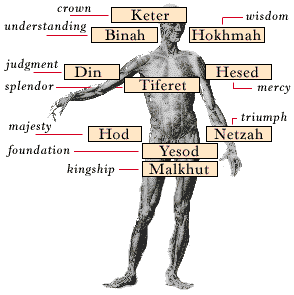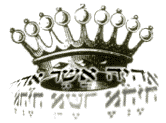|
The Zohar describes
the theosophic universe of God's hidden life (Eyn Sof) in symbolic,
and generally fixed, terms.
|
Keter
Elyon
|
the "supreme crown" of God
|
|
Hokhmah
|
the "wisdom" or primordial idea of God
|
|
Binah
|
the "intelligence" of God
|
|
Hesed
|
the "love" or mercy of God
|
|
Gevurah
or Din
|
the "power" of God, chiefly manifested as the power
of stern judgment and punishment
|
|
Rahamim
|
the "compassion" of God
|
|
Netsah
|
the "lasting endurance" of God
|
|
Hod
|
the "majesty" of God
|
|
Yesod
|
the "basis" or "foundation" of all active
forces in God
|
|
Malkhut
|
the "kingdom" of God (the mystical archetype of Israel
community; also described as Shekhinah)
|

These ten sefirot
are the ten spheres of divine manifestation in which God emerges from
His hidden abode. The sefirot, referred to in the Zohar as "the
mystical crowns of the Holy King,"[1]
together form the "unified universe" of God's life, the "world
of union" (alma de-yihuda).
The first sefirah — KETER (crown)
We will focus in this article on the first sefirah - keter (crown).
Keter is the highest and most glorious in the sefirot and crowns
them all. Because each sefirah is emanated from another, the highest
one, Keter, stands hierarchically above them all.... There are many
other names for Keter in the Kabbalah. It is often called Ayin
(nothingness) because it is beyond all existence and is nonetheless the cause
of all existing things. In the Prayer of Nehunyah ben ha-Kanah, written in
the thirteenth century, a hymn to Keter appears:
Everything
is in it,
for the internal powers of the sefirot are in it.
The vitality and existence of everything stem from it.
It is analogous to the soul
which gives life to the body
and constitutes it.
The constitution of everything is in Keter.
There is no front or back,
right or left in this sefirah.
It is called "indifferent unity."[2]
 Keter
is also called Hokhmah Penimit (internal wisdom) because it is the
hidden potentiality of divine wisdom before it is revealed. Keter is
the more active representation of God's will which cannot be known except
during the rare moments when God chose to reveal Himself as Ehyeh Asher
Ehyeh (I am what I am). The Kabbalists display a certain ambivalence about
whether Keter can be known.... Keter
is also called Hokhmah Penimit (internal wisdom) because it is the
hidden potentiality of divine wisdom before it is revealed. Keter is
the more active representation of God's will which cannot be known except
during the rare moments when God chose to reveal Himself as Ehyeh Asher
Ehyeh (I am what I am). The Kabbalists display a certain ambivalence about
whether Keter can be known....
If Keter cannot be known, it is because it is either identical with,
or only slightly different from Eyn Sof. Like a king who is hidden
from most of his subjects, he can be known by his venerable crown which is
filled with precious gems and diamonds. Keter is, however, identified
as divine thought and the source of all the other sefirot. The thirteenth-century
Tradition of Wisdom from the Sages of Mata Mehasya describes Keter:
Supernal Keter is a world hidden unto itself. All the sefirot
receive from its emanation even though it is separate, recondite and bound
up with the root of all roots which cannot be apprehended by thought. Keter
receives from the root without any interruption in a subtle whisper. It emanates
and pours forth from its reservoir upon the other crowns which are always
close to its emanation.[3]
Keter thus serves as the channelling of the infinite mind and will
into the more defined thought and will. It is the means by which the infinite
God makes all other creation possible. It is the transition between God's
infinity and the finite world.
A note on mystical achievement:
The highest stage of mystical achievement [devekut, meaning cleaving
to God] is intellectual. The mystic who masters the theurgic rituals and spiritual
discipline will have acquired a highly trained mystic consciousness. He may
be able to ascend the ladder of the sefirot beyond Shekhinah
and Binah to Hokhmah. No Jewish mystic can transcend Hokhmah
to Keter or Eyn Sof. The highest mystical achievement is union
with Hokhmah, at which level the mystic's consciousness is absorbed
into the intellect of God without becoming identical with the hidden God.
|
[1]
The great scholar of Jewish mysticism, Gershom Scholem, notes that
in the Zohar these sefirot are also referred to as:
• the mystical crowns of the Holy King
• the King's faces;
• the ten stages of the inner world, through which God descends
from the inmost recesses (Eyn Sof) down to His revelation;
• the garments of the Divinity;
• the beams of light which the Divinity sends out
• the creative names which God called into the world, the names
which He gave to Himself. [back]
[2] Quoted in Shlomo(Mordechai) Elishov,
Sefer Hakdamot u-Shearim (Pietrakov, 1904), 3a-4b. [back]
[3] Quoted in David Ariel, "Shem
Tob ibn She Tob's kabbalistic critique of Jewish philosophy"
(Hebrew. section). [back] |
|
 From:
The Mystic Quest by David Ariel, Schocken Books, 1992.
Reprinted with the permission of the author and the publisher. From:
The Mystic Quest by David Ariel, Schocken Books, 1992.
Reprinted with the permission of the author and the publisher.
|
CROWN
Table of Contents
|
|
|
|